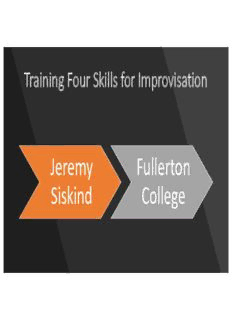
Siskind Presentation Four Skills for Improv PDF
Preview Siskind Presentation Four Skills for Improv
Training Four Skills for Improvisation Jeremy Fullerton Siskind College Separating the art of improvisation into its component Why do skillsets can make teaching and we care? learning less intimidating, more focused, and more effective. • What are we teaching when we teach improvisation? • Can improvisation be taught in a Questions linear manner? • Which skillsets does traditional to Consider music education emphasize? • Which skillsets are easier/harder to teach? To measure? E R E H T R A T S Which skill is your biggest strength or weakness as an improviser? Question As a teacher? When an Exercise is “Mastered”… Faster In a harder key/ More complex over a harder progression Training All Skillsets (1) Writing Down a Melody from a Recording Working with material Listening closely for the student loves and the melodic intervals or sense of intervals against the accomplishment of chords playing without music Learning to play the Using theory knowledge piece at the instrument to guess at the likeliest (maybe in multiple keys) notes in difficult spots Training All Skillsets (2) (2) Composing Writing something that Trusting the ear to tell the student feels proud them what the of or that reflects their composition needs next emotions Using theory knowledge Learning to play the to complete chord composition at the progressions and instrument melodies Training All Skillsets (3) (3) Transposing Gaining a deep Listening for melodic knowledge of a chord intervals and chord tone progression or melody relationships Thinking deeply about Feeling patterns in the intervallic different key centers relationships present Training Each Skill
Description: